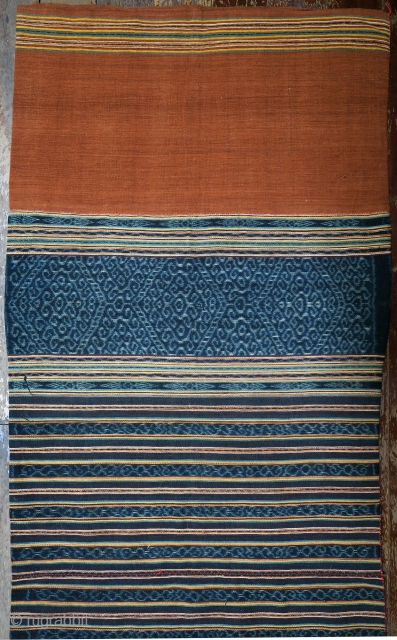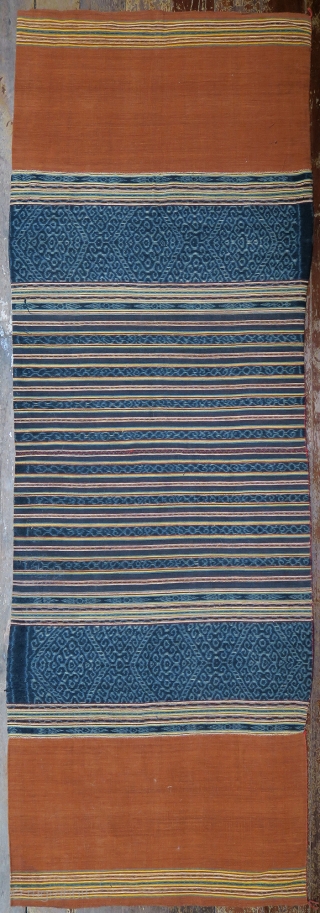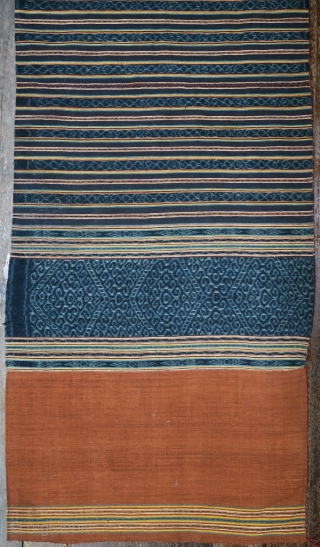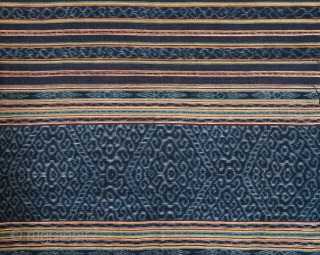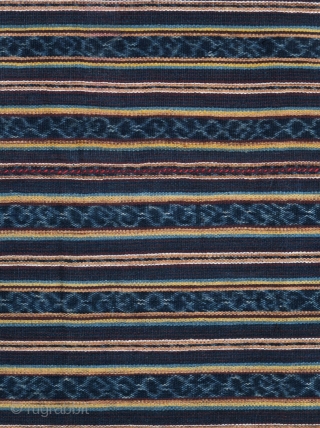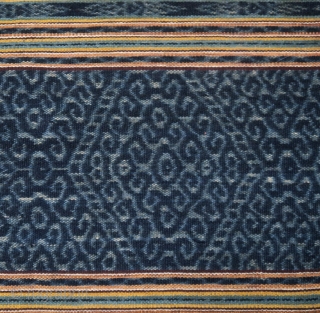Back
Indonesia | Timor vintage ikat skirt tais marobo
Indonesia, Timor, Malaka, Tetun people, third quarter of 20th century
Handspun cotton base, botanical indigo and aniline dyes, warp ikat, warp float
The skirt is made up of four panels, joined along the selvedges and then sewn together at the ends into a tube. The two solid nut-brown outer panels are decorated at the selvedge with compound pinstripes of honey, white, fawn and teal centred on ribbons of indigo warp float. The two mirroring inner panels form a banded body of richly saturated indigo ikat framed by compound stripes in the same light colours. The broadest ikat band near the ends carries a glimmering pattern of hooks arranged in hexagonal formation—tiuk oan in the ritual centre of Wehali, sometimes identified as a betel box—and is emphasized by meander ikat strips and a band of pierced double triangles. In the body, ikat bands with a linked chain are evenly interspaced by dot ikat ribbons. Emerging from an indigo ground pinstriped in maroon, the rhythmic balance of indigo patterns with stripes in soft modern hues manifests an old aesthetic. Fine handspun with a crisp, fresh hand.
Context: This tais marobo was probably made in the old Wewiku kingdom by an aristocratic lineage whose weavers made beautiful ikat cloth but were ritually prohibited from decorating their textiles with weft wrapping (sui). As in Wehali, their class required them to follow the dictum of their role: ‘to eat reclining, drink reclining’ (mahaa toba, mehemu toba). Laborious work like weft wrapped patterning was assigned to those around the ritual centre who gave annual tribute of highly decorated cloth and crops to aristocratic women, who could wear cloth with weft wrapped patterning only if it were woven by others. (Hamilton & Taromi, Textiles of Timor, 148-150)
The textile is in excellent condition. The colours are rich and vibrant, and the cotton is fresh, relatively light and robust, with a sandy hand.
w 57 cm x 170 cm
Provenance: Régis Bertrand Collection. Adhesive labels printed: “r13. mo1a”. Mr Bertrand was an agricultural engineer specializing in cotton who assembled his collection of traditional costumes with accessories from the 1960s to late 1990s. His focus was traditional fabrics hand-made by indigenous peoples of Asia (China, the Indian subcontinent, mainland Southeast Asia, Indonesia, Central Asia and the Middle East) and Central America (Mexico, Guatemala). Collected in the field by Mr. Bertrand, these textiles are primarily clothes for everyday life to which were added ceremonial pieces.
Indonesia, Timor, Malaka, Tetun people, third quarter of 20th century
Handspun cotton base, botanical indigo and aniline dyes, warp ikat, warp float
The skirt is made up of four panels, joined along the selvedges and then sewn together at the ends into a tube. The two solid nut-brown outer panels are decorated at the selvedge with compound pinstripes of honey, white, fawn and teal centred on ribbons of indigo warp float. The two mirroring inner panels form a banded body of richly saturated indigo ikat framed by compound stripes in the same light colours. The broadest ikat band near the ends carries a glimmering pattern of hooks arranged in hexagonal formation—tiuk oan in the ritual centre of Wehali, sometimes identified as a betel box—and is emphasized by meander ikat strips and a band of pierced double triangles. In the body, ikat bands with a linked chain are evenly interspaced by dot ikat ribbons. Emerging from an indigo ground pinstriped in maroon, the rhythmic balance of indigo patterns with stripes in soft modern hues manifests an old aesthetic. Fine handspun with a crisp, fresh hand.
Context: This tais marobo was probably made in the old Wewiku kingdom by an aristocratic lineage whose weavers made beautiful ikat cloth but were ritually prohibited from decorating their textiles with weft wrapping (sui). As in Wehali, their class required them to follow the dictum of their role: ‘to eat reclining, drink reclining’ (mahaa toba, mehemu toba). Laborious work like weft wrapped patterning was assigned to those around the ritual centre who gave annual tribute of highly decorated cloth and crops to aristocratic women, who could wear cloth with weft wrapped patterning only if it were woven by others. (Hamilton & Taromi, Textiles of Timor, 148-150)
The textile is in excellent condition. The colours are rich and vibrant, and the cotton is fresh, relatively light and robust, with a sandy hand.
w 57 cm x 170 cm
Provenance: Régis Bertrand Collection. Adhesive labels printed: “r13. mo1a”. Mr Bertrand was an agricultural engineer specializing in cotton who assembled his collection of traditional costumes with accessories from the 1960s to late 1990s. His focus was traditional fabrics hand-made by indigenous peoples of Asia (China, the Indian subcontinent, mainland Southeast Asia, Indonesia, Central Asia and the Middle East) and Central America (Mexico, Guatemala). Collected in the field by Mr. Bertrand, these textiles are primarily clothes for everyday life to which were added ceremonial pieces.
price:
Reserved
- Home
- Antique Rugs by Region
- Category
- Profiles
- Post Items Free
- Albums
- Benaki Museum of Islamic Art
- Budapest: Ottoman Carpets
- Gulbenkian Museum
- Islamic Carpets. Brooklyn
- Islamic Textiles. Brooklyn
- Konya Museum: Rugs
- MKG, Hamburg
- MMA: Caucasian Carpets
- MMA: Mamluk Carpets
- MMA: Mughal Indian Carpets
- MMA: Ottoman Carpets
- MMA: Safavid Persian Carpets
- MMA: Turkmen Rugs
- McCoy Jones Kilims
- Ottoman textiles. Met
- Philadelphia Museum
- Rugs and Carpets: Berlin
- Seljuqs at the Met
- TIEM, Istanbul: Carpets
- V&A: Classical Carpets
- Vakiflar Carpets: Istanbul
- Baluch Rugs: Indianapolis
- Gallery Exhibitions
- Jaf an Exhibition
- Alberto Levi Gallery
- Andean Textile
- Christie's London: 2016
- Francesca Galloway
- HALI at 40
- ICOC Washington, DC 2018
- Jajims of the Shahsavan
- London Islamic Week April, 2018
- Mongolian Felts
- Navajo Rugs: JB Moore
- Persian Piled Weavings
- SF Tribal & Textile Art Show 2020
- SF Tribal 2019
- Sotheby's: C. Alexander
- Turkish Prayer Rugs
- Turkmen Main Carpets ICOC 2007







